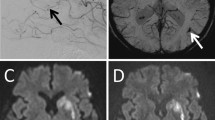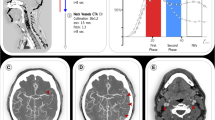Abstract
Although magnetic resonance angiography (MRA) is accepted for showing chronic intracranial stenotic or occlusive lesions, the method has not been practically examined in patients with acute cerebral ischaemia. We carried out three-dimensional time-of-flight MRA in six patients with acute ischaemia treated by local thrombolysis, and compared the findings with those of digital subtraction angiography (DSA). In all patients, MRA before thrombolysis clearly demonstrated the occluded arteries, which corresponded precisely to those shown by DSA. In four patients with complete recanalisation of the occluded vessels after thrombolysis, the recanalisation could be demonstrated by postoperative MRA. In one patient with reocclusion of the recanalised artery, repeat MRA also demonstrated the reocclusion, confirmed by DSA. These results suggest that MRA may be helpful for noninvasive investigation before and after thrombolysis.
Similar content being viewed by others
Author information
Authors and Affiliations
Additional information
Received: 10 September 1997 Accepted: 17 January 1998
Rights and permissions
About this article
Cite this article
Ohue, S., Kohno, K., Kusunoki, K. et al. Magnetic resonance angiography in patients with acute stroke treated by local thrombolysis. Neuroradiology 40, 536–540 (1998). https://doi.org/10.1007/s002340050642
Issue Date:
DOI: https://doi.org/10.1007/s002340050642




